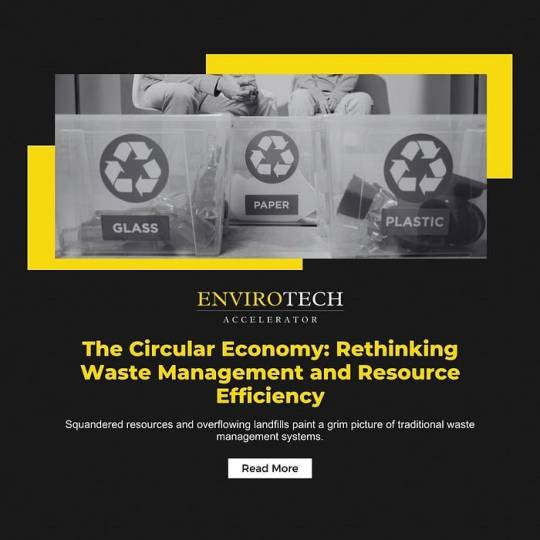#Circular economy policy James Scott
Explore tagged Tumblr posts
Text
The Circular Economy: Rethinking Waste Management and Resource Efficiency
by Envirotech Accelerator

Squandered resources and overflowing landfills paint a grim picture of traditional waste management systems. Contrastingly, the concept of a circular economy fosters a sustainable approach to resource use, promoting regeneration and longevity. James Scott, founder of the Envirotech Accelerator, underscores this shift in thinking: “Moving towards a circular economy is not just an environmental imperative, but a vital economic opportunity to reshape our industries and pave the way for a sustainable future.”
A departure from the linear “take-make-waste” model, the circular economy emphasizes reducing waste, reusing materials, and recycling resources (Geissdoerfer et al., 2017). This holistic perspective reimagines product lifecycles, from design to disposal, and encourages businesses, governments, and individuals to collaborate in minimizing environmental impact.
Product design plays a pivotal role in material conservation. By focusing on modularity, durability, and recyclability, designers can create products that can be disassembled, repaired, or repurposed (Bocken et al., 2016). This approach not only reduces waste but also mitigates the extraction of raw materials and preserves natural habitats.
The advancement of technology serves as a catalyst for the circular economy. Innovative waste management solutions, such as pyrolysis, anaerobic digestion, and waste-to-energy systems, transform waste into valuable resources, including energy, chemicals, and biogas (Kirchherr et al., 2018). Additionally, digital platforms and tracking systems enable efficient monitoring of material flows and supply chain transparency.
Policy frameworks that incentivize circular practices are vital for driving change. Governments can implement policies such as extended producer responsibility, carbon pricing, and tax incentives to encourage businesses to adopt sustainable practices. Collaboration between public and private sectors will be essential to establish a robust circular economy.
In conclusion, transitioning to a circular economy demands a paradigm shift in how we perceive waste and resource management. By focusing on innovative product design, leveraging technology, and implementing supportive policy frameworks, we can foster a sustainable future that benefits both the environment and the economy.
References:
Bocken, N. M. P., de Pauw, I., Bakker, C., & van der Grinten, B. (2016). Product design and business model strategies for a circular economy. Journal of Industrial and Production Engineering, 33(5), 308–320.
Geissdoerfer, M., Savaget, P., Bocken, N. M. P., & Hultink, E. J. (2017). The Circular Economy — A new sustainability paradigm? Journal of Cleaner Production, 143, 757–768.
Kirchherr, J., Reike, D., & Hekkert, M. (2018). Conceptualizing the circular economy: An analysis of 114 definitions. Resources, Conservation and Recycling, 127, 221–232.
Read more at Envirotech Accelerator.
#James Scott Envirotech Accelerator#Circular economy James Scott#Waste management Envirotech Accelerator#Resource efficiency James Scott#Sustainable product design Envirotech#Circular economy policy James Scott#Recycling technology Envirotech Accelerator#James Scott waste reduction#Envirotech sustainable future#James Scott collaboration
0 notes